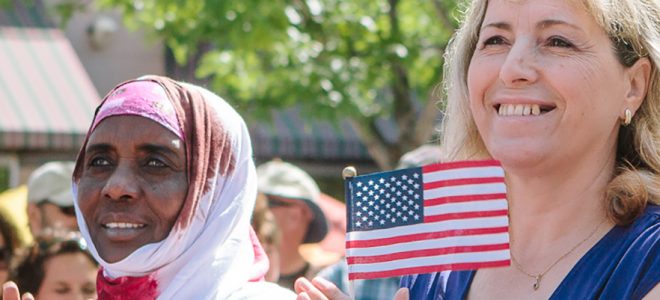
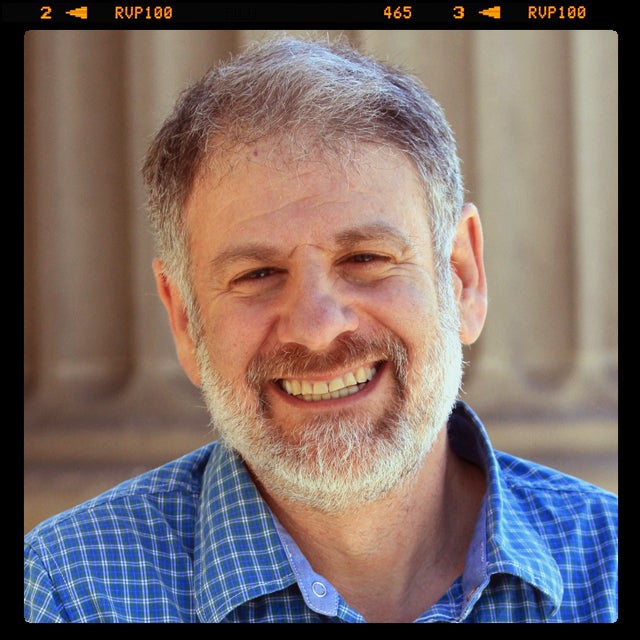
Todd Shallat, Ph.D., is professor emeritus of history and urban studies at Boise State University.
In one of the whitest of American places in one of the reddest American states, one out of every 16 people has been forced across an international border in flight from persecution and war. Thirteen thousand arrived as “displaced persons” with refugee status. Hailing from the Balkans, the Congo, the Himalayas, the Tigris-Euphrates, and the Horn of Africa, crossing oceans of suspicion and misunderstanding, they reach Idaho’s capital city at a pace of about 800 people a year.
Asmaa Albukaie of Syria reached Boise via Jordan and Egypt. Married at age 14 and the mother of two at 15, she had attended university library school before the car bombs blasted Damascus. Rockets exploded with chemical sarin warheads. She hid in a basement with neighbors. Her husband and children were kidnapped. Retrieving her children, she fled.
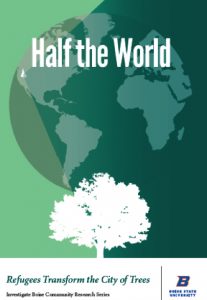
Boise State’s School of Public Service and Urban Studies Programs invite you to a book signing and celebration for Half the World: Refugees Transform the City of Trees. 7 PM, Thursday, June 8. Rediscovered Books, 180 N 8th St, Boise.
“I force[d] to leave [be]cause my children,” Albukaie told a reporter. “We couldn’t sleep because of the shooting and bombs.”
Across Jordan by bus and ferry, harassed, pickpocketed and swindled, the fatherless family of three eventually reached the United Nations in Cairo. Two years of vetting followed. Interrogations in windowless rooms – at least 10 that she remembers – seemed fixated on her headscarf as if her hair were hiding a bomb. Interpol, U.S. Homeland Security, the U.S. State Department, the U.S. Department of Health and Welfare, U.S. Customs, and the TSA all layered the cumbersome process. At last in December 2014, deemed “vulnerable” and prioritized because of the children, Albukaie and her sons were approved. The final stack of papers revealed that her family’s destination was a city seldom mentioned in Hollywood movies. She Googled the place in the airport. Inexplicably, the tickets read “Boise, ID.”
“So green. It’s beautiful,” said Albukaie of her mystery city. In July 2016, posing for a story in the Idaho Statesman, she wore western denim with a flower-print tee and a hijab of bright magenta. Bright eyes flashed toward the sun.
“I have a lot of nice [Boise] friends. I’m working. I’m safe.” Even so, people have cursed her in public. Drivers yelled ugly words when her clunker stalled in an intersection. A Boise woman, wide-eyed, turned to her companion and whispered “the Muslims are coming” when Albukaie entered a bank.
“[People] are talking about how we are stranger[s] … how we are ISIS.” The hysteria has frightened her children and left an indelible mark. “I’m here for safety. I’m not scared. I still believe in the United States. But everyone know[s] I am Muslim if they saw me. I am a woman who wears a scarf.”
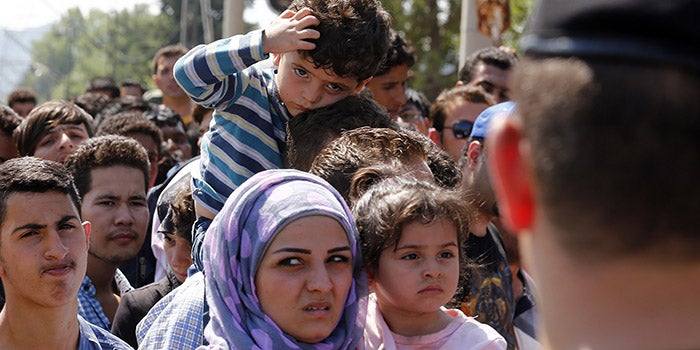
SHOUTING DISTANCE
Albukaie stays resolute in the face of accusations that Syrians are Muslim fanatics and that hate is the soul of Islam. “A Trojan Horse of ISIS” was how Donald Trump characterized the Syrian resettlement program. “Creeping Sharia” was the slur preferred by Idahoans who sponsored a bill to de-Islamize the state’s child welfare system. In downtown Boise, a Nampa man was arrested and charged with a hate crime for punching Albukaie’s 16-year old son. The assailant had asked the boy if he was Muslim.
“Maybe it’s our problem,” Albukaie concedes. “Maybe we don’t know how to deal with American people. I’m trying just to fix and solve the problem, because I need peace for this country. For me, America is now my country, so I need peace too. So I need to be safe with my kids, and I need safety for my neighbors, for American people.”
Peace and safety seemed doomed in the wake of the 2015 terror attacks on Paris and San Bernardino. In Filer, Idaho, a pastor packed a small Baptist church to preach against the “Muslim refugee agenda.” Boise, said the pastor, was a “refugee dump.” In Twin Falls, meanwhile, hijabs had been spotted near the College of Southern Idaho campus at the refugee resettlement center. A news report claimed that Syrians had videotaped the gang-rape of a disabled 5-year-old child at knifepoint. Twin Falls police quickly denied it: no Syrians, no rape, no knife. All that the prosecutor would acknowledge was that “juveniles” had been involved in an “incident.” The court records were sealed. Immediately, nevertheless, Breitbart News reposted the story. In a flash, the fiction went viral.
Governor C.L. “Butch” Otter saw the firestorm coming. Already Idaho’s governor had joined two dozen others in demanding a halt to “rubber-stamped” immigration-refugee programs. No matter the confusion between refugees (who are forced to migrate) and immigrants (who are not). No matter that refugee matters were far removed from the governor’s jurisdiction. “Frustration runs high in Idaho,” said Otter. The narrative seemed to confirm that strangers were evil and that refugee resettlement was, like the flooding Boise River, too fast and out of control.
The 2017 Frank Church Conference, to be held in late October, will discuss immigration and refugee issues. Visit the Frank Church Institute website for more details as they become available.Two blocks from Otter’s Statehouse – shouting distance but political light-years from the governor’s office – Mayor David H. Bieter ignited his own fiery headline by drafting a defiant response. “When it comes to immigration and refugees,” wrote Bieter to his fellow mayors, “presidents and Congress get to say, but mayors have to do.”
Boise’s mayor rejected the notion that people from distant places posed a threat to public safety. Boise was live-and-let-live, said Bieter. It was the kind of place where artists painted the utility boxes, where an overpass sheltered a skate park, where motorists allowed people to merge so long as they waved back to acknowledge the kindness. “We’re nationally known as a welcoming city,” Bieter continued. “We can all be proud.”
Pride in the welcoming city had become a rallying point for the four-term incumbent in Boise’s previous mayoral election. Himself an outsider looking in – a Catholic in a Protestant city, a Democratic in a Republican state – Hizzoner embodied the broad-brush American epic of the grandson who wants to remember what the father would rather forget. His maternal grandfather, a sheepherder, had emigrated from the Basque region of Spain. Threadbare and persevering, the immigrant had taken a job few people wanted, making a life. The sheepherder’s daughters had been married in the Catholic cathedral that marked the Democratic home base of the future mayor. In 2015, during Bieter’s fourth mayoral campaign, his challenger had scorned “too many dialects” in Boise and refugees as “blight.” The mayor coldly responded that “diversity” was Boise’s birthright. Bieter then cruised to an electoral landslide with 69% of the vote.
Both an immigrant city and an anti-immigrant city, Boise, historically, had shunned prejudice but also endorsed it depending on what was at stake. In 1893 the Japanese laborers who laid rails to the 10th Street depot were confined to shiver in boxcars when threatened by mobs downtown. In 1901, a Bavarian immigrant mayor named Moses Alexander allied with a British sheriff to roughly remove the Chinese. That same Bavarian built an ornate synagogue and became the nation’s first elected Jewish governor. Boise beckoned, but Boiseans sometimes repelled.
Pitchfork nativism, even so, never played well in Boise. In 1924, when the Knights of the Ku Klux Klan rallied on Boise’s Main Street, city council insisted that the hooded marchers expose their faces in honest daylight. In 1948, when an Idaho senator shunned “whites only” and was arrested in Alabama, Boiseans applauded the rebuke of Jim Crow.
Concern for war refugees first appeared in the Idaho Statesman in opposition to U.S. Senator William Borah. The square-jawed attorney from Boise had risen to national stature as the prosecutor of radical labor bosses. In the 1920s, he lent a shoulder to barring the door to “undesirables” from Asia and Mexico who, he alleged, could not be assimilated. An isolationist, Borah opposed asylum for Germany’s Jews. After Borah’s death and the Nazi slaughter, the refugee issue resurfaced in the problem of Europe’s “displaced persons” whose homes had been bombed into graveyards. President Harry Truman, in 1948, had signed the Displaced Persons Act “with very great reluctance” because the legislation discriminated against Catholics and Jews. Boise philanthropist Leo J. Falk and others supported Truman, advocated asylum, and funded resettlement programs. In 1951 the Statesman polled Boiseans to ask whether the United States should do more.
“If we can help, it is our duty to do it,” said Phyllis Vanderwilt of Rose Hill, responding to the Statesman’s query. Betty Horn of Eagle agreed but cautioned that there needed to be a quota. Likewise Arleta Vanderford, a Kuna housewife, did not want America “flooded” but noted that many Holocaust survivors were good people and “highly educated.” Idaho might benefit from their skills.
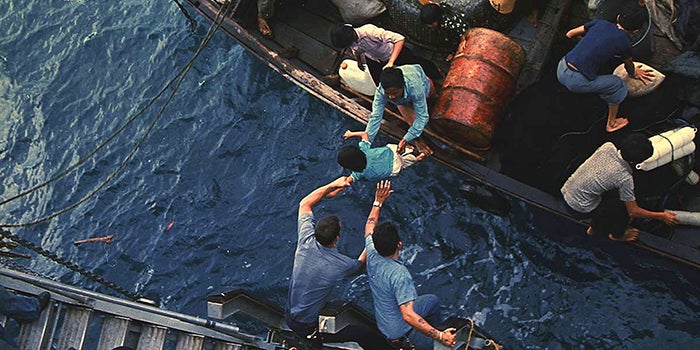
OWING TO A WELL-FOUNDED FEAR
In 1951, as Boiseans pondered asylum, a landmark United Nations treaty codified the word “refugee” in international law. Signed in Geneva, grandfathered into U.S. federal statue by Congress in 1967, the Convention on the Status of Refugees established the principle that no innocent person should be remanded to face torture or execution. A “refugee” was defined as any person forced to migrate “owing to a well-founded fear of being persecuted for reasons of race, religion, nationality, membership of a particular social group, or political opinion.”
Cubans fleeing Castro in 1960 were among the first in the United States with official refugee status. Hungarians, Czechoslovakians, Russians, and Ukrainians followed as Congress cracked open the door for dissidents from the Soviet bloc. In 1975, with the fall of Saigon, Congress authorized two years’ worth of funds for people fleeing Cambodia and Vietnam. However, Indochinese continued to arrive, and by midyear 1979 some 14,000 were reaching the United States each month.
In Idaho, meanwhile, an informal refugee program began at Boise State University in 1975. The program later passed to Idaho’s Department of Health and Welfare and, in 1997, to a private non-profit. Today the umbrella organization is called Jannus, in tribute to the Roman god of new beginnings. The state’s resettlement administrator is called the Idaho Office for Refugees.
WELCOME THE STRANGER
Jan Reeves, 71, the longtime director of the refugee office, leans back from piles of printouts in the Jannus building behind a North End strip mall. “We have a receptive community,” says Reeves in response to the question of why refugees come to Boise. “We have resources. There are opportunities here. There are many community partners that are engaged in the resettlement process. Refugees have an opportunity here to start their lives over on a solid footing with a positive future ahead of them. And that’s what we want.”
In 2016 the Idaho office resettled 1,245 displaced people. Two-thirds were resettled in Boise, the rest in Twin Falls. The single largest group was 602 refugees from the Democratic Republic of Congo (former Zaire). Next in numbers were Syrians (148) and Iraqis (122). The numbers suggest that most will build lives in the Boise area. Since 1975, of an estimated 24,500 refugees and asylum-seekers who have reached Idaho through various channels, about 19,000 remain.
But in Idaho, as in the rest of America, mythology clouds the process. One pervasive fiction is that the United States does not have the bureaucratic capacity to adequately vet refugees from Near East war zones. Security experts say otherwise. America’s refugee screening process has been called the most arduous ever invented. In 2016, in testimony before the U.S. Senate’s immigration subcommittee, Homeland Security’s Leon Rodriguez said there was no harder way to enter the country than as a refugee. “All refugees,” he insisted, “are subject to the highest level of security check of any category of any traveler to the United States.” Homeland Security could confirm “not a single act of terrorist violence” committed by a screened refugee.
A second fiction is that refugees bleed the coffers of public assistance. Taxpayer support, in fact, is a pittance once refugees land. A family of four in Boise might get $782/month for up to eight months. Refugees have 40 months to repay the cost of their flight to freedom. Refugees, like any American, immediately pay state and federal taxes, and, like any American, the poorest among them pay the highest percentage of their household income. In 2016, in response to a public petition, the Twin Falls school superintendent tallied the annual cost of refugee services. The total annual cost to the school budget was less than half of one percent.
“If refugees weren’t self-sufficient, that would be a problem, but that’s not what’s happening,” said Zeze Rwasama, who directs the College of Southern Idaho’s refugee center.
A third, more complex, fiction is the notion that refugees displace other workers. In the short run, if the Boise Valley were a zero-growth economy of stagnation, it could be argued that any influx of workers would devastate wages. But studies of the long run have shown that refugees in agricultural regions can reduce the dependence on guest or undocumented workers by filling undesirable jobs. Some start businesses that employ other people. Refugees are also consumers. Less likely than other immigrants to leave once established, they are “integral to the nation’s growth” according to a panel of 14 academic economists in their 2016 report to the National Academies of Sciences, Engineering, and Medicine. “We found little-to-no negative effects on overall wages and employment of native-born workers in the longer term,” said Francine D. Blau of Cornell, who led the study.
Entrepreneurship is also important. A 2016 report from the Center for American Progress found that Bosnians, after ten years in the workforce, were about as likely to open a business as the American born. Thirty-one of every 1,000 Bosnians had become business owners; so had 26 of every 1,000 Burmese and 26 of every 1,000 Somalis. The Syrian-born, who are typically skilled and well-educated, were three times more likely to open a viable business than the American-born.
Sadly, not everyone prospers. Refugees, for all their resilience, face the same economy as other Boiseans seeking employment – an economy of call centers and baristas, a city with too few apartments close to a job or a bus stop. Idaho suffers from the nation’s highest percentage of employment at minimum wage. And that minimum is $2.50 less than the minimum an hour away across the Oregon line. Fifteen percent of people in the Boise Valley live in poverty by federal standards. Another 22 percent are so-called ALICE workers (Asset Limited, Income-Constrained, Employed) who earn less than the minimum needed for housing, groceries, and health care.
Transportation is another problem. The federal transit administration has ranked Boise at 251 out of 290 cities for public transportation. For people who spent years in camps without cars or driver’s licenses, that statistic is especially tough.
“You know, new country is supposed to be hard,” says Nowela Virginie of Boise by way of Rwanda. The mother of two, age 23, she spent 16 years in a Tanzanian refugee camp. Virginie reached Boise in 2009 at the nadir of the Great Recession, when employment for the newly arrived had dipped to 55 percent. She has since found work as a maid in a Boise motel.
“If you have a job, you have education, is not hard. Is good,” says Virginie. “But the bad thing, if you don’t speak any English, is so hard – really hard.”
It’s no wonder Idahoans seem to be all over the map on refugee resettlement issues. In 2016, in a Boise State University poll of 1,000 Idahoans, a statewide plurality (48.8 percent) thought that refugees burdened the local economy. But the poll also suggested that familiarity bred respect. Among respondents who had contact with refugees, a sizable majority (66 percent) had positive experiences. The more people knew about refugees, the better they were perceived.
“They’re going to provide such richness to our way of life,” says Luke Carter of Boise, a refugee mentor who was recently featured on the mayor’s website. Carter and Sally, his wife, feel “humbled” to have befriended a hard-working family from Burma. “Basically, we’re family. We all fit together. They want to be good Americans. They want to contribute. They’re here to stay.”

Excerpted and adapted from Half the World: Refugees Transform the City of Trees, Todd Shallat, ed, Investigate Boise Community Research Series, vol. 8. Boise: Boise State University, 2017.